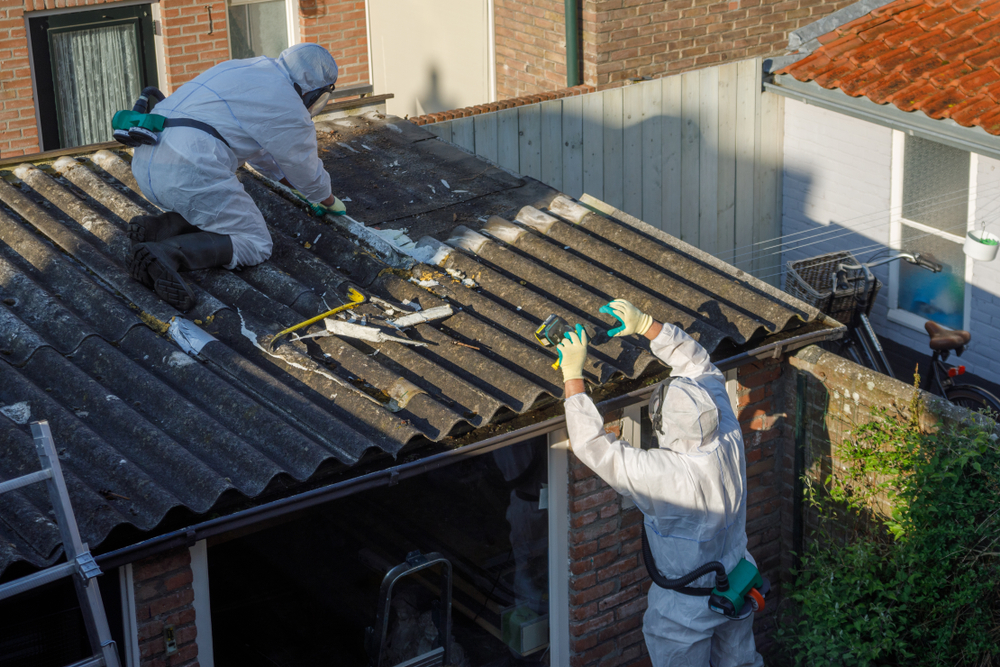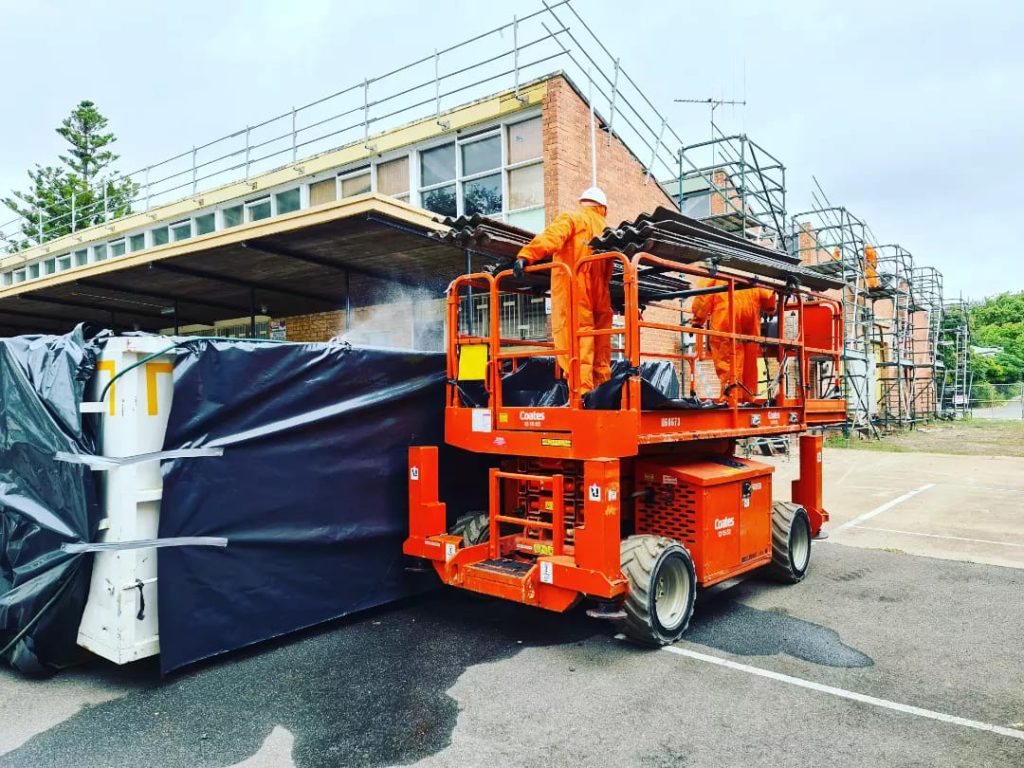
Wondering how to renovate safely when renovating with asbestos is in the mix? Managing this hazardous material is key to protecting your family and staying within legal bounds. In this guide, we lay out essential steps for discerning if asbestos is present in your home and offer practical advice for removing it securely during your renovation.
Asbestos was the material of choice in construction before the 1990s owing to its heat resistance, strength, and insulation properties. It’s often found within insulation, flooring tiles, and even vintage textiles such as oven mitts and dish towels. However, identifying asbestos materials is not straightforward. It’s nearly impossible to confirm the presence of asbestos by sight alone, posing a significant challenge for homeowners and renovators.
In this process, we aim to enhance your understanding of two key aspects: how to recognise asbestos materials and identify common areas in your home where asbestos may be present. These insights will arm you with the knowledge to embark on your renovation journey confidently.
Asbestos is a chameleon of sorts. It can appear in a variety of colours such as:
And its appearance can change significantly depending on the materials it’s mixed with. When processed, asbestos can break down into fluffy fibres, altering its texture and form.
You might come across non-friable asbestos products like asbestos cement and vinyl asbestos floor tiles, commonly known as ‘fibro’ in the form of asbestos cement sheeting. Gaining knowledge about these variations in asbestos materials, including asbestos containing products and asbestos fibres, is an important step towards safeguarding your living environment.

Asbestos was a jack-of-all-trades in the construction industry, used in various parts of the home. It might be lurking anywhere, including:
However, don’t rely solely on labelling for identification as the presence of asbestos may not always be indicated on materials.
The crux of the matter is that asbestos isn’t just a nuisance during renovations – it’s a health hazard. When asbestos-containing materials are disturbed, they release tiny fibres into the air. Once inhaled, these fibres can cause serious health risks such as malignant mesothelioma and lung cancer.
Asbestos becomes most hazardous when damaged, as this can lead to the release of fibres into the air. Crucially, there is no known safe level of exposure to asbestos, making any contact with the material potentially hazardous and highlighting the risks asbestos poses.
In order to manage these risks, we will expand on the different forms of asbestos and ways to protect your loved ones from exposure.
Asbestos comes in two main forms: friable and non-friable, also known as bonded asbestos. Friable asbestos materials, like insulation around hot water pipes and loose-fill asbestos, can be easily crumbled by hand pressure, releasing fibres into the air. On the other hand, non-friable asbestos products such as asbestos cement sheeting and vinyl asbestos floor tiles are less likely to release fibres unless damaged or aged.
While non-friable asbestos in good condition is generally low risk, there is no safe level of asbestos exposure. This is why the removal of friable asbestos must be carried out by a licensed asbestos removalist with specific qualifications, ensuring compliance with safety codes of practice.
When dealing with asbestos, it’s not just about your own safety but that of your family and neighbours. It’s crucial to prevent the release of asbestos fibres into the air during renovations to safeguard everyone’s health. This includes informing neighbours about renovation work involving asbestos and the safety measures being taken.
The work area should be cordoned off to prevent unprotected individuals, including family members, from entering when asbestos is being removed. Additionally, those removing asbestos should wear protective equipment, such as disposable coveralls and a P2 respirator, to prevent contamination and protect family members. There’s much more to ensuring the safety of your family, which we will discuss in the following sections.
Before you pick up that sledgehammer and start demolishing walls, there are essential precautions to consider. Always treat all suspected asbestos materials as if they contain asbestos until they have been tested and proven otherwise. If building materials are damaged or if your renovation plans will involve disturbing them, the EPA recommends testing for asbestos.
If you suspect the presence of asbestos materials in your home, minimize activities that could disturb them and release fibres into the air. In guiding you through this process, we will highlight the need for consulting a licensed asbestos professional and the importance of acquiring appropriate permits.

Engaging a licensed asbestos assessor for asbestos testing is not just essential for safety; it’s a legal requirement. A licensed asbestos professional ensures:
Identifying the presence of friable or non-friable asbestos cannot be confirmed by sight or smell and requires a licensed assessor to find asbestos. They should inspect the property and provide a comprehensive report, a critical component of managing asbestos-related risks.
Having covered the precautions, we now turn our attention to the details of safe asbestos removal techniques. Before starting the removal process, it’s critical to have an asbestos removal plan that complies with the relevant Code of Practice and Workplace Health and Safety (WHS) laws. Setting up safety measures includes sealing the work area with plastic sheeting, utilizing negative air pressure units, and posting warning signs to prevent exposure of individuals to asbestos.
Safe handling of asbestos involves wetting the material before removal, minimizing fibre release, and proper disposal by double-bagging wet waste in sealed containers with appropriate labels. After asbestos has been removed, all surfaces within the area must be meticulously decontaminated, using damp cloths and HEPA vacuums to eliminate any lingering fibres.
Let’s explore the tools and equipment needed, and the essential protective gear for this process.
When it comes to asbestos removal, the tools you use can have a significant impact on safety. While the temptation to use power tools might be strong, it’s crucial to avoid them as they can release fibres into the air. If a power tool is necessary, using a cordless drill at less than 650 rpm along with dust suppression can be considered.
Understanding and using the correct tools can significantly reduce the risk of asbestos exposure, ensuring that your renovation project is not just successful, but also safe.
Personal protective equipment (PPE) is your best friend when working with asbestos. For respiratory protection, a half-face filter respirator with a class P1 or P2 filter cartridge, or a class P1 or P2 disposable respirator is recommended, ensuring it meets Australian Standard AS1716. It’s also crucial for males to be clean-shaven to ensure a proper seal between their face and the mask for an airtight fit.
Disposable coveralls that comply with European Standards Type 5 and Type 6 are advised to prevent clothing contamination during asbestos removal and should be disposed of with other asbestos waste after use. After removal, decontamination includes disposing of coveralls, wiping boots, and showering to remove any asbestos dust particles on the skin.
Disposing of asbestos waste is a task that carries immense responsibility, not just for your health but also for the wellbeing of the environment. The safe removal and transportation of asbestos waste is overseen by local safety authorities, the Environment Protection Agency, and local councils.
Asbestos waste must be stored and disposed of in a way that minimizes risks to people and the environment and is only acceptable at licensed landfills. Illegally dump asbestos products or asbestos waste in regular rubbish bins or during council ‘hard rubbish’ collections incurs significant health risks to workers and the community and is prohibited by law.
Ignoring the guidelines and regulations surrounding asbestos can result in severe consequences, both for your health and your wallet. Mishandling asbestos can lead to fines of up to $7,500 for individuals and $15,000 for companies, with potential court penalties of up to $1,000,000.
Employing licensed professionals guarantees compliance with local laws and regulations, shielding homeowners from possible fines or legal consequences. In the ensuing subsections, we will address the specific fines and penalties for non-compliance and discuss the benefits of seeking legal counsel.

Engaging professional asbestos removalists like Asbestos Australia is crucial for safely managing asbestos, especially during renovations where the risk of disturbing this hazardous material is high. Asbestos, known for its serious health risks including lung cancer and mesothelioma, requires expert handling to effectively mitigate these dangers. Our team at Asbestos Australia is expertly trained to identify and safely remove asbestos, navigating the complexities of its management with precision and care.
The process involves detailed planning, from identification to disposal, adhering strictly to Codes of Practice and Workplace Health and Safety (WHS) laws. We emphasize the use of specialized techniques for friable asbestos, which is more prone to releasing fibres, and ensure the safety of homeowners and the community through the use of personal protective equipment (PPE) and safe removal practices. This includes avoiding the use of power tools that can release asbestos fibres into the air and ensuring proper containment and disposal methods.
Choosing Asbestos Australia not only ensures the health and safety of your family and neighbours but also guarantees legal compliance, protecting you from potential fines and legal issues. Trust in our expertise to handle your asbestos removal needs with the highest standards of safety and professionalism.
For top-tier asbestos removal services in Melbourne, Geelong, or anywhere in Victoria, Asbestos Australia is your definitive choice. Our team’s unparalleled expertise ensures your property is safe and compliant, handling every aspect of asbestos removal with precision and care. Don’t let asbestos put your health or project at risk. Trust the safety of your environment to the specialists at Asbestos Australia. Contact us today by calling us on 03 9704 2952 and secure a worry-free, professional solution for your asbestos concerns. Your safety is our priority—let us take the worry out of your hands.
Posted By: Tommy Clappers
Leave a Reply